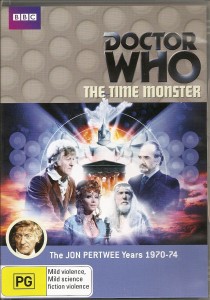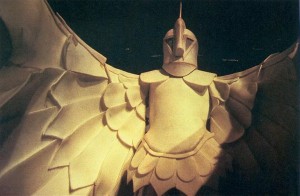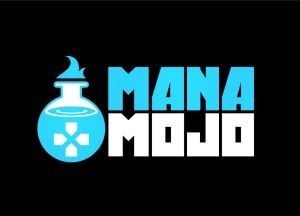 Welcome to the thirty-eighth instalment of Who Review, my ongoing quest to review all available episodes of TV’s longest running SF series, Doctor Who. This week, The Master returns once more to battle the Doctor in The Time Monster.
Welcome to the thirty-eighth instalment of Who Review, my ongoing quest to review all available episodes of TV’s longest running SF series, Doctor Who. This week, The Master returns once more to battle the Doctor in The Time Monster.
EPISODES
The Time Monster
BROADCAST DATES
20 May – 24 June 1972 (6 episodes)
THE DOCTOR
Jon Pertwee
THE COMPANIONS
Jo Grant
THE EPISODES
The Doctor suffers a disturbing dream about the Master. In the dream, the villain is standing beside a trident-shaped crystal, laughing maniacally as the world explodes around him. Waking from the dream, he enquires about any recent earthquakes, and learns that such an event has been reported on the Thera Islands. Jo informs him that the islands are the purported location for the lost city of Atlantis.
At the Newton Research Unit at Cambridge University, the Master, using the alias of Professor Thascalos, has enslaved Dr Percival, the Director of the Institute. The villain is using the trident-shaped crystal to conduct time experiments. His TOMTIT (Transmission of Matter through Interstitial Time) experiment, assisted by Ruth Ingram and Stuart Hyde, focuses on transmitting matter by breaking it down into light waves. However, the experiment is a cover for his true purpose; the summoning of a being he refers to as Kronos.
Back at UNIT HQ, the Master’s experiments register on the Doctor’s Time Detector, a device he has created to track the Master. Following the signal, the Doctor and Jo head to Cambridge, where they find time is moving slower than normal. The TOMTIT experiment is disrupting the flow of time, and Hyde is caught in the backlash, aging decades in an instant. Fortunately, the Doctor is able to shut the experiment down.
The Brigadier has also arrived at the Institute with some dignitaries to witness the TOMTIT experiments. He orders the facility evacuated and a hunt for The Master begins.
Examining the crystal, the Doctor determines that it is Atlantean in origin, and can be used to summon a creature called Kronos. He explains that there are creatures called Chronovores that live outside space-time and feed off time energy. Kronos is the most fearsome of the Chronovores, responsible for the destruction of Atlantis.
Despite the search, The Master is able to continue his experiments. He transports Krasis, an Atlantean priest, through time to the present. The Master seizes the Seal of Kronos from the priest and uses it to control the Chronovore, invoking Kronos to materialise in the room. The creature appears, but The Master cannot contain it. Krasis surmises that this is because the Master is using a small fragment of a much larger crystal.
The Doctor is able to once again disrupt the Master’s experiment. In turn, The Master summons warriors from different time periods to attack his nemesis. During the battle, Hyde is restored to his original aid, while Sargent Benton is reduced to infancy and the Brigadier and his troops are frozen in time.
The battle continues through time, as The Doctor attempts to place his TARDIS inside the Master’s, a risky manoeuvre that, if mistimed, could result in both time machines occupying the same space/time co-ordinates, resulting in a destructive event known as a time Ram. Fortunately, the Doctor manages to place his TARDIS inside the Master’s.
Confronting the Master, the Doctor is unable to dissuade him from summoning Kronos. The Chronovore devours the Doctor, sending him into the time vortex, but Jo is able to rescue him.
The Master flees to ancient Atlantis, where he meets King Dalios, ruler of the ancient city. Dalios is far older than he looks, and remembers the time when Kronos was worshipped as a God in Atlantis. His people wish to return to those days, heedless to the King’s warnings that Kronos is a curse on the city.
Although the Master’s efforts to win over the King prove futile, he manages to manipulate the vain and gullible Queen Galleia into aiding him.
The Doctor and Jo arrive in Atlantis and meet with the King, who enlists their aid in saving Atlantis. Jo is taken by an Atlantean named Lakis to see the Queen and overhears the Master and Galleia discussing their plans. They reveal that the full crystal is hidden in a maze guarded by a fearsome Minotaur. Jo dispatches Lakis to warn King Dalios and the Doctor.
Unfortunately, Jo captured by Krasis and thrown into the labyrinth, where she is attacked by the Minotaur. The Doctor is able to save her by sending the creature plummeting into a pit. Together, they find the crystal, but they are captured by Krasis, who takes them to the Master.
With the aid of Galleia, The Master has usurped the throne of Atlantis. He has the Doctor and Jo imprisoned in a cell with King Dalios, who has been tortured and beaten. Unfortunately, the King dies from his wounds.
Jo and the Doctor are taken to the main square, where Galleia presents the Master to the Atlantean Council. The Master declares that he will summon Kronos. Jo informs Galleia that King Dalios is dead.
Realising that she truly loved the King, Galleia orders the Master seized, but Krasis summons Kronos before the guards can react. The Master orders the Chronovore to destroy Atlantis, then takes Jo hostage and flees in his TARDIS. As Atlantis falls, The Doctor pursues The Master in his own TARDIS.
The Doctor contacts the Master and threatens him with a time ram, but The Master calls his bluff. Within the Master’s TARDIS, Jo causes the time ram to occur, and both TARDISes become trapped in the time vortex. The Time Ram frees Kronos, who saves the Doctor and Jo and returns them to the TARDIS. On the Doctor’s insistence, the Master is also spared, but he manages to escape in his own TARDIS before he can be apprehended.
The Doctor and Jo return to the Institute as Ingram and Hyde operate the TOMTIT machine one last time, thereby returning the UNIT men to normality, albeit leaving Benton in a nappy. The machine then overloads.
MY THOUGHTS
The Time Monster is something of a mixed storyline. There are some very strong, most notably the Doctor/Master interplay, which has been the true highlight of the entire Pertwee era to date. The Master’s appearance adds gravitas to any storyline and his manipulative scheming is always a joy to watch.
Unfortunately, there are a great many flaws to the story. The depiction of Atlantis is particularly disappointing. The opportunity to present a truly wondrous and imaginative version of the lost city is wasted on a lacklustre, rather dull presentation. In a season that gave us the cultural complexities of Peladon and Solos (in The Mutant), this lack of creativity is especially telling.
The Time Monster is not the first time Atlantis has been mentioned, or even seen, in Doctor Who. In fact, this storyline provides the third explanation for the sinking of Atlantis. In The Daemons, the Destruction of the fabled city was said to have been caused by Azel. In the (sadly lost) Underwater Menace, Atlantis is destroyed by the villain Zaroff. I think there might be an interesting story in these varying depictions of the city’s destruction.
The interior of the TARDIS was redesigned for this episode, but it was damaged during recording. As it turns out, producer Barry Letts wasn’t impressed with the redesign anyway, so it was scrapped.
An interesting piece of trivia for SF fans: The Minotaur is played by David Prowse, who would of course go on to play Darth Vader in the Star Wars trilogy.
Overall, The Time Monster is an ambitious story that doesn’t really work in its execution. The first three episodes, set almost entirely on present-day Earth, could have easily been compacted into 1 or 2 episodes, and the latter episodes don’t deliver a convincing or compelling depiction of Atlantis.
THE DOCTOR
There is a wonderful interlude between The Doctor and Jo where he tells her a story of his childhood:
“When I was a little boy, we used to live in a house that was perched halfway up the top of a mountain. Behind our house, there sat under a tree an old man. A hermit, a monk. He’d lived under this tree for half his lifetime, so they said, and had learned the secret of life. So, when my black day came, I went and asked him to help me.'”
The story is one liberally taken from Buddhism, but the more spiritual and philosophical story suits his character well. Barry Letts was heavily influenced by Buddhism, and many elements from Buddhist philosophy can be seen in this period of Doctor Who.
During The Time Monster, we learn that The Doctor’s reaction times are ten times faster than those of a human.
THE VILLAINS
The Time Monster is yet another fine showing for The Master, as he hatches yet another insidious and far-reaching scheme. At this point, there’s really not much more to say about The Master; Roger Delgado has honed his portrayal of the character to a fine art and the script writers are giving him perfect dialogue to match.
Kronos, unfortunately, is one of the rare examples of execution completely failing intent in a Who storyline. When watching Doctor Who, it’s important to acknowledge the limited budgetary and time constraints under which these episodes were produced. I give a lot of leeway to the special effects in this regard. Unfortunately, Kronos looks some incredibly silly that it’s hard to take him seriously as a threat.
Producer Barry Letts suggested to director Paul Bernard that flames of incandescent blue light be added to the Kronos effect, steps that I believe would have added to Kronos’ appearance. Unfortunately, Bernard disagreed.
The idea of Chronovores living outside the time stream is an interesting one that could be explored further. Unfortunately, this is Kronos’ only appearance in the series to date and none of the other Chronovores are seen.
FINAL THOUGHTS
The Time Monster is one of the weaker stories to appear during this era of Who, possibly second only to The Claws of Axos.
2.5 Lukes
NEXT
The Doctor celebrates his tenth anniversary with The Three Doctors.









